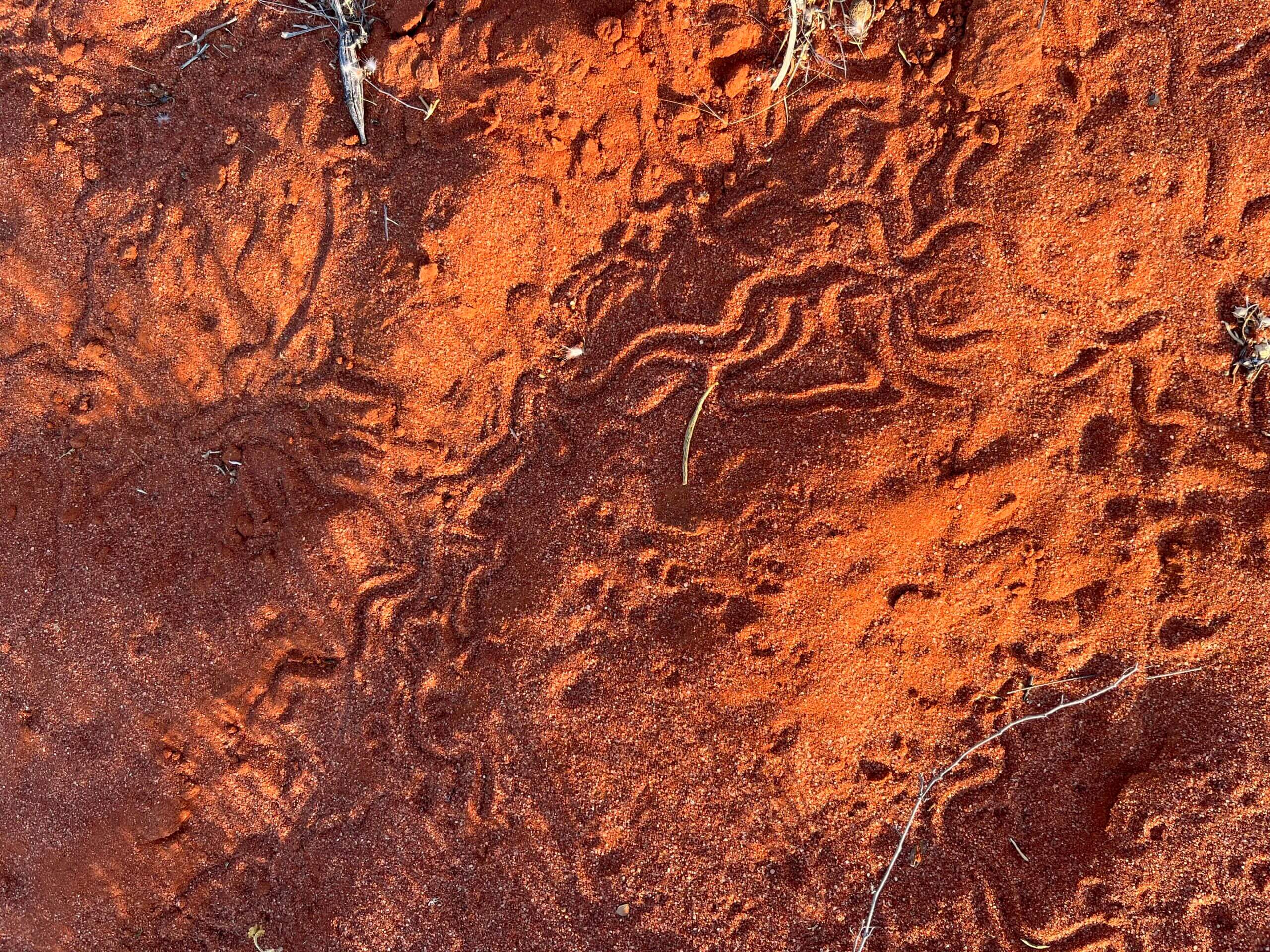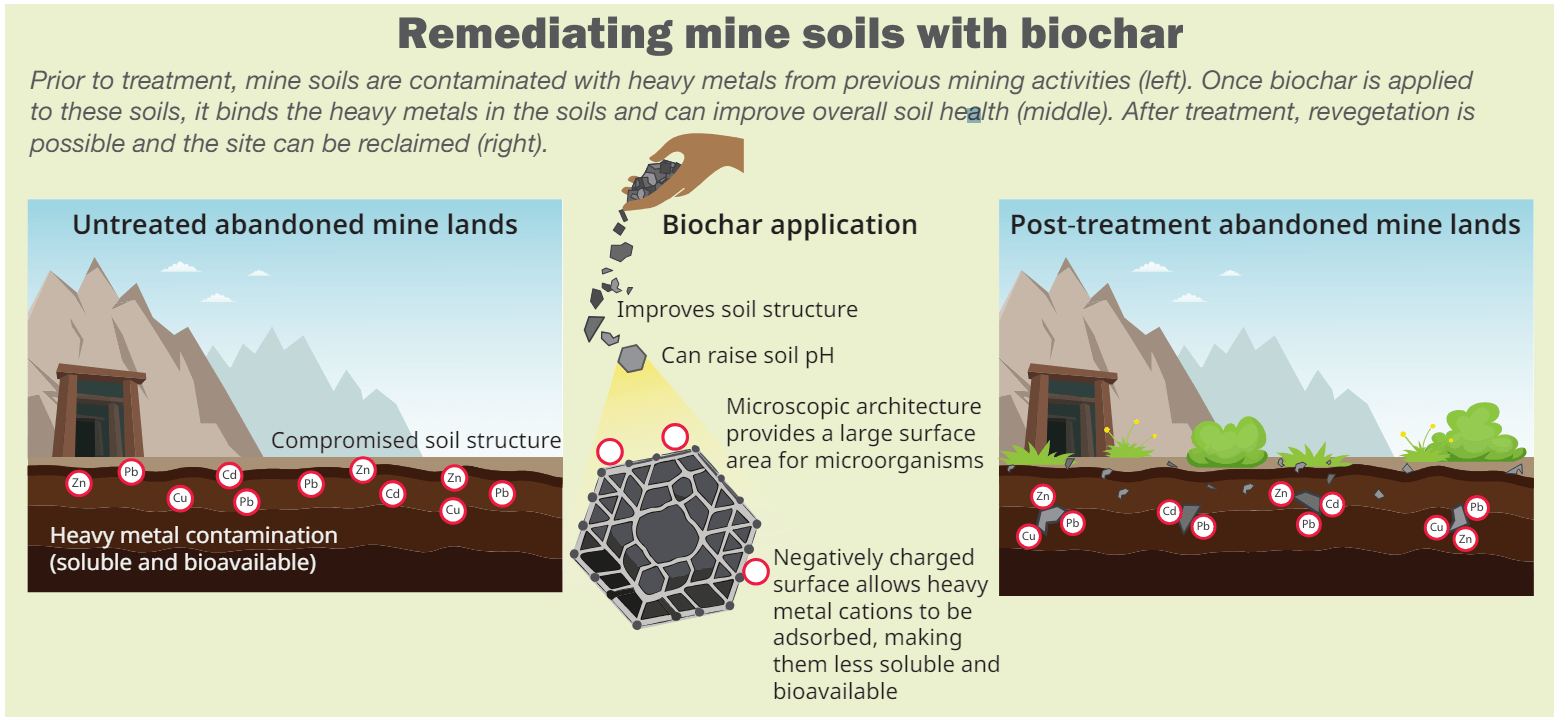- June 18, 2024

Soil Health and Soil Amendments for Mine Rehabilitation
One of the many challenges with mine-disturbed landscapes lies in the impact of mining activities on soil health and quality. Understanding the importance of soil health and quality and the science behind soil amendments plays a crucial role in effective mine rehabilitation efforts.
In discussing soil health, it is also important to distinguish among industry terms such as rehabilitation, reclamation, and remediation, as each term plays a specific role in returning mine-disturbed lands to a functional and sustainable state for future land use. Our previous Conversation on Closure, “Rehab, Reclaim, Remediate – The Three R’s of Returning Land Use” is a helpful resource in establishing these distinctions.

Figure 1: Distinguishing between rehabilitation, reclamation, and remediation.
Despite their distinctive processes, each contributes to successfully returning disturbed landscapes by optimizing various site conditions that impact soil health.
The Difference Between Soil Health and Soil Quality
Soil health provides a comprehensive view of soil functionality, encompassing functions essential for ecosystem stability, including nutrient cycling, water retention, and habitat provision (Baumgartl et al., 2021). A distinction between soil health and soil quality developed by Stutler (2019) is summarized below:
- Soil quality is defined as the “capacity of a specific kind of soil to function within natural or managed ecosystem boundaries to sustain plant and animal productivity, maintain or enhance water and air quality, and support human health and habitation” (Doran & Parking, 1994, as cited in Stutler, 2019).
- Soil health refers to “the continued capacity of soil to function as a vital living system within ecosystem and land-use boundaries, sustaining biological productivity, promoting the quality of air and water environments, and maintaining plant, animal, and human health” (Doran & Safely, 1997, as cited in Stutler, 2019).
The concept of soil health is commonly used to inform the overall condition or quality of soil materials, extending its scope to broader sustainability objectives, while soil quality usually emphasizes the immediate environmental context (Lehmann et al., 2020). Despite their distinct scopes, in this article, soil health and soil quality will be used interchangeably.
Importance of Soil Health for Mine Rehabilitation
Preserving and maintaining healthy soil is essential for successful site rehabilitation and restoration (USDA, 2021). It is essential that rehabilitated soils help sustain diverse vegetation communities that support wildlife habitat and prevent erosion (Shrestha & Lal, 2011). As defined in our conversation on Rehab, Reclaim, Remediate – The Three R’s of Returning Land Use, rehabilitation commonly refers to the process of restoring mine-disturbed land to the pre-disturbed or similar state.
However, in today’s practice, mine rehabilitation is not limited to achieving pre-disturbance conditions. In some instances, returning a heavily affected landscape to its original state may not be feasible within a realistic time frame. Instead, rehabilitation efforts should aim to establish a self-sustaining ecosystem that supports both ecosystem and landscape functionality, tailored to the returning land use.
Monitoring soil health is also critical in order to quantify successful reclamation efforts and the overall performance of soil systems (Baumgartl et al., 2021). Soil health monitoring helps determine the necessity and effectiveness of potentially using soil amendments.
In some cases, the soils or materials being used in rehabilitation efforts do not have the health and quality properties that are needed in a self-sustaining ecosystem and require some form of improvement or amelioration. One form of amelioration is the addition of soil amendments.
Soil Amendments for Mine Rehabilitation
Proper application of soil amendments can improve soil quality and support revegetation efforts. Amendments can enhance soil quality by balancing pH levels, adding organic carbon and soil nutrients, optimizing water retention, reestablishing microbial communities, and reducing compaction (US EPA, 2007). Some amendments can also play a role in preventing contaminant mobilization, thereby limiting bioavailability, which is the degree to which contaminants in soil are absorbed by organisms (US EPA, 2007; National Research Council, 2003).
Types of commonly used soil amendments include:
- Mineral fertilizer
Mineral fertilizer is a commonly used amendment to significantly improve the nitrogen content of mine tailings, which is often deficient and crucial for establishing vegetation post-mining (Addai et al., 2023).
Nitrogen content in mineral fertilizers not only serves as an energy source for soil microorganisms but also aids in nutrient cycling, thereby enhancing soil fertility (Addai et al., 2023). Phosphorus is also a key element in mineral fertilizers that promote root development and the formation of root nodules (Wasis et al., 2019).
Studies emphasize that for rehabilitation purposes, effective incorporation of fertilizers promotes larger biomass and seedling growth by establishing an evenly proliferated root system (George et al., 2006).
- Biosolids
Biosolids can be used to provide essential nutrients such as nitrogen and phosphorus to facilitate plant and root growth (US EPA, 2007; Zhang, 2017; Johnson, 2021). Biosolids as a soil amendment have been shown to enhance water holding capacity, lessen wind and water erosion, and increase aeration due to the addition of organic matter (Zhang, 2017).
Due to having nutrient-rich composition, biosolids can improve infertile and degraded soils at certain mine sites and increase the recreational value of the land (Wijesekara et al., 2016). For instance, by improving soil nutrients and fertility, it facilitates vegetation establishment, which can enhance wildlife habitats and sustain local communities engaged in recreational land use activities such as foraging and hunting.
However, biosolids should not be applied to soil beyond the limits of the vegetation’s nutrient needs as there may be excessive nutrient loading concerns, which can potentially cause environmental problems such as ground or surface water pollution and depressing plant growth and yields (US EPA, 2007; Zhang, 2017).
- Biochar
Biochar may also influence carbon sequestration through biotic and abiotic reactions with soil components (Luo et al., 2023). Soil minerals and microorganisms undergo the breakdown or binding of biochar’s labile (readily decomposable) and recalcitrant (less readily decomposable) fractions (Luo et al., 2023).
Due to its high PH levels, incorporating biochar can also neutralize harmful chemical compounds in mine-affected soil, potentially reducing acidity and the bioavailability of heavy metals and other contaminates (Ippolito, 2019; Ghosh, 2020; USDA, 2024). However, due to the various sources of biochar, each biochar must be treated as a unique material and tested to achieve site-specific objectives (Nepal et al., 2023).
For example, a study concluded that biochar derived from plant biomass contained the lowest concentrations of heavy metals, while coal waste biochar exhibited the highest concentrations (Kujawska, 2023). Although it is important to note that these metal concentrations in biochar remain within acceptable ranges for soil application (Kujawska, 2023).

Figure 2: Remediating mine soils with biochar (USDA, 2024).
- Engineered soils
Engineered soils can be developed from artificially produced plant substrates, like sand, gravel, soil, or even mine tailings, combined with other soil amendments to create soil-like substrates (Weiss et al., 2021; Wu et al., 2023). Engineered soils require thorough evaluation and proper selection and ratio of soil materials such that they become suitable for vegetation (Shukla et al., 2021).
This approach involves eco-engineering, where abiotic and biotic inputs—such as organic matter, pioneer plants, soil microbes, and irrigation—are used to initiate and accelerate the formation of functional soil aggregates (Wu et al., 2023). These aggregates can help support sustainable vegetation cover, promoting diverse plant colonization and improving the overall health and stability of rehabilitated mine sites where sufficient volumes of soil are otherwise unavailable (Wu et al., 2023).
Okane’s Approach
At Okane, we specialize in addressing the complex challenges of rehabilitating mine-affected land and soil. Our approach emphasizes the early integration of mine closure and rehabilitation planning into mine development and operation. This proactive strategy ensures rehabilitation and reclamation are incorporated from the outset to meet future land-use goals and the expectations of regulators, Indigenous rightsholders, and key stakeholders.
We prioritize salvaging and preserving soil resources during development and throughout operations to support the re-establishment of long-term, self-sustaining ecosystems post-mining. Our risk-based approach develops site-specific remediation guidelines based on comprehensive investigations, considering site characteristics, soil nutrient content, vegetation nutrient requirements, contaminant behaviour, and potential exposure pathways. By tailoring solutions to each site’s specific conditions, we apply more effective and cost-efficient remediation strategies.
In a research and development collaboration with Profile Products and the University of Saskatchewan’s Multi-purpose Slope Testing (MOST) Facility, we are exploring surface amendments to improve vegetation establishment on cover systems. To learn more, check out Okane’s Cover Depth and Vegetation Health Study.
Our team of experts works closely with clients to develop effective solutions to unique challenges. To learn more about our rehabilitation and reclamation solutions, reach out to us at info@okaneconsultants.com.
References
Addai, P., Mensah, A. K., Sekyi-Annan, E., & Adjei, E. O. (2023). Biochar, compost and/or NPK fertilizer affect the uptake of potentially toxic elements and promote the yield of lettuce grown in an abandoned gold mine tailing. Journal of Trace Elements and Minerals, 4. https://doi.org/10.1016/j.jtemin.2023.100066
Baumgartl, T., Chan, J., Bucka, F., & Pihlap, E. (2021). Soil organic carbon in rehabilitated coal mine soils as an indicator for soil health. In A. B. Fourie, M. Tibbett, & A. Sharkuu (eds), Mine Closure 2021: Proceedings of the 14th International Conference on Mine Closure. QMC Group. https://doi.org/10.36487/ACG_repo/2152_121
George, S. J., Tibbett, M., Braimbridge, M. F., Davis, S. G., Vlahos, S., & Ryan, M. (2006). Phosphorus fertiliser placement and seedling success in Australian Jarrah Forest. In A. B. Fourie & M. Tibbett (eds), Mine Closure 2006: Proceedings of the First International Seminar on Mine Closure, Australian Centre for Geomechanics, Perth, pp. 341-349. https://doi.org/10.36487/ACG_repo/605_27
Ghosh, D. & Maiti, S. K. (2020). Can biochar reclaim coal mine spoil? Journal of Environmental Management, 272. https://doi.org/10.1016/j.jenvman.2020.111097
Ippolito, J., Cui, L., Novak, J. M., & Johnson, M. G. (2019). Biochar for mine-land reclamation. In Ok, Y. S., Tsang, D. C., Bolan, N., & Novak, J. M. (eds), Biochar from Biomass and Waste: Fundamentals and Applications (pp. 75–90). ScienceDirect. http://dx.doi.org/10.1016/B978-0-12-811729-3.00005-4
Johnson, J. D. (2021, August 01). How Plants Use Nutrients. WVU Extension. https://extension.wvu.edu/lawn-gardening-pests/news/2021/08/01/how-plants-use-nutrients
Kujawska, J. (2023). Content of heavy metals in various biochar and assessment environmental risk. Journal of Ecological Engineering, 24(8), 287–295. https://doi.org/10.12911/22998993/166557
Lehmann, J., Bossio, D. A., Kögel-Knabner, I., & Rillig, M. C. (2020). The concept and future prospects of soil health. Nature Reviews Earth & Environment, 1(10), 544–553. https://doi.org/10.1038%2Fs43017-020-0080-8
Luo, L., Wang, J., Lv, J., Liu, Z., Sun, T., Yang, Y., & Zhu, Y. (2023). Carbon sequestration strategies in soil using biochar: advances, challenges, and opportunities. Environmental Science & Technology, 57(31), 11357–11372. https://doi.org/10.1021/acs.est.3c02620
National Research Council. (2003). Bioavailability of contaminants in soils and sediments: Processes, tools, and applications. Washington, DC: The National Academies Press.
Nepal, J., Ahmad, W., Munsif, F., Khan, A., & Zou, Z. (2023). Advances and prospects of biochar in improving soil fertility, biochemical quality, and environmental applications. Frontiers Environmental Science, 11. https://doi.org/10.3389/fenvs.2023.1114752
Shrestha, R. & Lal, R. (2011). Changes in physical and chemical properties of soil after surface mining and reclamation. Geoderma, 161(3–4), 168–176. https://doi.org/10.3389/fenvs.2023.1114752
Shukla, K., Mishra, R., & Sarkar, P. (2021). Understanding soilless engineered soil as a sustainable growing material for food production in a green roof. Materials Today Proceedings, 43(5), 3054–3060. https://doi.org/10.1016/j.matpr.2021.01.397
Stutler, D. K. (2019). Soil health assessment in reclaimed mine soils [Graduate’s thesis, West Virginia University]. https://researchrepository.wvu.edu/etd/4021/
United States Department of Agriculture (USDA). (2021). Soil disturbance rehabilitation: A desk guide to techniques and monitoring. US Department of Agriculture, Forest Service.
USDA. (2024). Mining for answers: Using biochar to remediate abandoned mine lands. US Department of Agriculture, Forest Service.
United States Environmental Protection Agency (US EPA). (2007). The use of soil amendments for remediation, revitalization, and reuse. US Environmental Protection Agency.
Wasis, B., Ghaida, S. H., & Winata, B. (2019). Application of coconut shell charcoal and NPK fertilizer toward Acacia mangium growth on the soil of ex-limestone mining in Bogor, Indonesia. Archives of Agriculture and Environmental Science, 4(1), 75–82. https://dx.doi.org/10.26832/24566632.2019.0401012
Weiss, O., Minixhofer, P., Werner, N., Riedenbauer, S., Olesko, E., Lübke, K., Scharf, B., & Pitha, U. (2021). Alternative engineered soils and seed mixes used for seepage troughs. Land, 10(11). https://doi.org/10.3390/land10111152
Wijesekara, H., Bolan, N. S., Kumarathilaka, P., Geekiyanage, N., Kunhikrishnan, A., Seshadri, B., Saint, C., Surapaneni, A., & Vithanage, M. (2016). Chapter 3: Biosolids enhance mine site rehabilitation and revegetation. Environmental Materials and Waste 2016, 45–71. https://doi.org/10.1016/B978-0-12-803837-6.00003-2
Wu, S., Liu, Y., Southam, G., Nguyen, T., Konhauser, K., You, F., Bougoure, J., Paterson, D., Chan, T., Lu, Y., Haw, S., Yi, Q., Li, Z., Robertson, L., Hall, M., Saha, N., Ok, Y., & Huang, L. (2023). Ecological engineering of iron ore tailings into useable soils for sustainable rehabilitation. iScience, 26(7). https://doi.org/10.1016%2Fj.isci.2023.107102
Zhang, H. (2017). Using biosolids as a plant nutrient source (Report No. CR-2201). Oklahama State University. https://extension.okstate.edu/fact-sheets/print-publications/cr/using-biosolids-as-a-plant-nutrient-source-cr-2201.pdf
